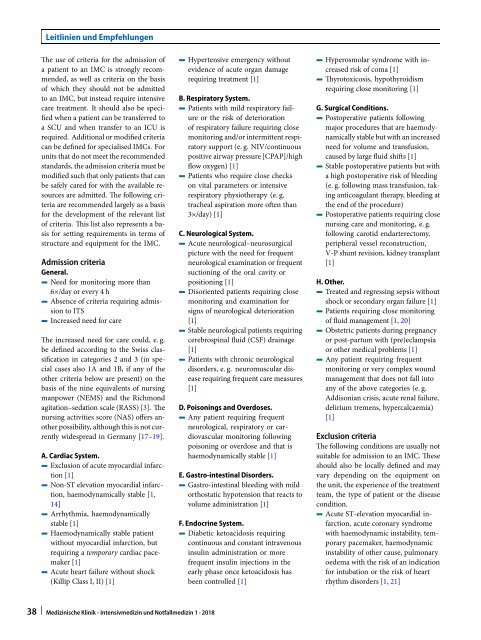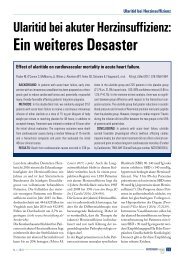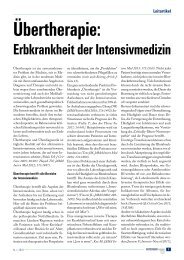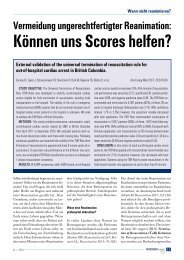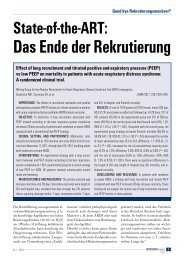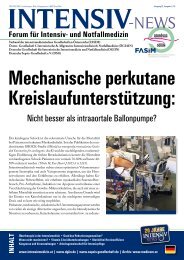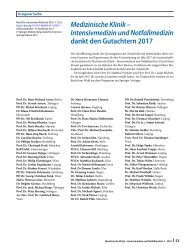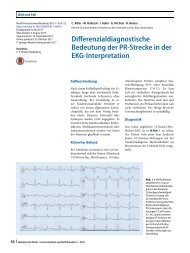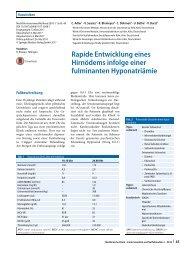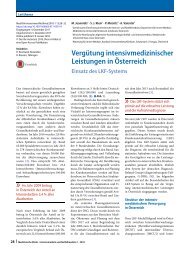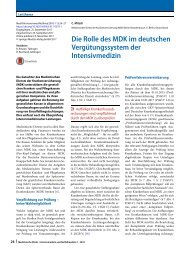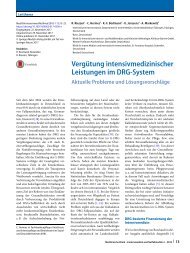07 Intermediate care units
Create successful ePaper yourself
Turn your PDF publications into a flip-book with our unique Google optimized e-Paper software.
Leitlinien und Empfehlungen<br />
The use of criteria for the admission of<br />
a patient to an IMC is strongly recommended,<br />
as well as criteria on the basis<br />
of which they should not be admitted<br />
to an IMC, but instead require intensive<br />
<strong>care</strong> treatment. It should also be specified<br />
when a patient can be transferred to<br />
a SCU and when transfer to an ICU is<br />
required. Additional or modified criteria<br />
can be defined for specialised IMCs. For<br />
<strong>units</strong> that do not meet the recommended<br />
standards, the admission criteria must be<br />
modified such that only patients that can<br />
be safely <strong>care</strong>d for with the available resources<br />
are admitted. The following criteria<br />
are recommended largely as a basis<br />
for the development of the relevant list<br />
of criteria. This list also represents a basisforsettingrequirementsintermsof<br />
structure and equipment for the IMC.<br />
Admission criteria<br />
General.<br />
4 Need for monitoring more than<br />
6×/day or every 4 h<br />
4 Absence of criteria requiring admission<br />
to ITS<br />
4 Increased need for <strong>care</strong><br />
The increased need for <strong>care</strong> could, e. g.<br />
bedefinedaccordingtotheSwissclassification<br />
in categories 2 and 3 (in special<br />
cases also 1A and 1B, if any of the<br />
other criteria below are present) on the<br />
basis of the nine equivalents of nursing<br />
manpower (NEMS) and the Richmond<br />
agitation–sedation scale (RASS) [3]. The<br />
nursing activities score (NAS) offers another<br />
possibility, although this is not currently<br />
widespread in Germany [17–19].<br />
A. Cardiac System.<br />
4 Exclusion of acute myocardial infarction<br />
[1]<br />
4 Non-ST elevation myocardial infarction,<br />
haemodynamically stable [1,<br />
14]<br />
4 Arrhythmia, haemodynamically<br />
stable [1]<br />
4 Haemodynamically stable patient<br />
without myocardial infarction, but<br />
requiring a temporary cardiac pacemaker<br />
[1]<br />
4 Acute heart failure without shock<br />
(Killip Class I, II) [1]<br />
4 Hypertensive emergency without<br />
evidence of acute organ damage<br />
requiring treatment [1]<br />
B. Respiratory System.<br />
4 Patients with mild respiratory failure<br />
or the risk of deterioration<br />
of respiratory failure requiring close<br />
monitoring and/or intermittent respiratory<br />
support (e. g. NIV/continuous<br />
positive airway pressure [CPAP]/high<br />
flow oxygen) [1]<br />
4 Patients who require close checks<br />
on vital parameters or intensive<br />
respiratory physiotherapy (e. g.<br />
tracheal aspiration more often than<br />
3×/day) [1]<br />
C. Neurological System.<br />
4 Acute neurological–neurosurgical<br />
picture with the need for frequent<br />
neurological examination or frequent<br />
suctioning of the oral cavity or<br />
positioning [1]<br />
4 Disoriented patients requiring close<br />
monitoring and examination for<br />
signs of neurological deterioration<br />
[1]<br />
4 Stable neurological patients requiring<br />
cerebrospinal fluid (CSF) drainage<br />
[1]<br />
4 Patients with chronic neurological<br />
disorders, e. g. neuromuscular disease<br />
requiring frequent <strong>care</strong> measures<br />
[1]<br />
D. Poisonings and Overdoses.<br />
4 Any patient requiring frequent<br />
neurological, respiratory or cardiovascular<br />
monitoring following<br />
poisoning or overdose and that is<br />
haemodynamically stable [1]<br />
E. Gastro-intestinal Disorders.<br />
4 Gastro-intestinal bleeding with mild<br />
orthostatic hypotension that reacts to<br />
volume administration [1]<br />
F. Endocrine System.<br />
4 Diabetic ketoacidosis requiring<br />
continuous and constant intravenous<br />
insulin administration or more<br />
frequent insulin injections in the<br />
early phase once ketoacidosis has<br />
been controlled [1]<br />
4 Hyperosmolar syndrome with increased<br />
risk of coma [1]<br />
4 Thyrotoxicosis, hypothyroidism<br />
requiring close monitoring [1]<br />
G. Surgical Conditions.<br />
4 Postoperative patients following<br />
major procedures that are haemodynamically<br />
stable but with an increased<br />
need for volume and transfusion,<br />
caused by large fluid shifts [1]<br />
4 Stable postoperative patients but with<br />
a high postoperative risk of bleeding<br />
(e. g. following mass transfusion, taking<br />
anticoagulant therapy, bleeding at<br />
the end of the procedure)<br />
4 Postoperative patients requiring close<br />
nursing <strong>care</strong> and monitoring, e. g.<br />
following carotid endarterectomy,<br />
peripheral vessel reconstruction,<br />
V-P shunt revision, kidney transplant<br />
[1]<br />
H. Other.<br />
4 Treated and regressing sepsis without<br />
shock or secondary organ failure [1]<br />
4 Patients requiring close monitoring<br />
of fluid management [1, 20]<br />
4 Obstetricpatientsduringpregnancy<br />
or post-partum with (pre)eclampsia<br />
or other medical problems [1]<br />
4 Any patient requiring frequent<br />
monitoring or very complex wound<br />
management that does not fall into<br />
any of the above categories (e. g.<br />
Addisonian crisis, acute renal failure,<br />
delirium tremens, hypercalcaemia)<br />
[1]<br />
Exclusion criteria<br />
The following conditions are usually not<br />
suitable for admission to an IMC. These<br />
should also be locally defined and may<br />
vary depending on the equipment on<br />
the unit, the experience of the treatment<br />
team, the type of patient or the disease<br />
condition.<br />
4 Acute ST-elevation myocardial infarction,<br />
acute coronary syndrome<br />
with haemodynamic instability, temporary<br />
pacemaker, haemodynamic<br />
instability of other cause, pulmonary<br />
oedema with the risk of an indication<br />
for intubation or the risk of heart<br />
rhythm disorders [1, 21]<br />
38 Medizinische Klinik - Intensivmedizin und Notfallmedizin 1 · 2018


